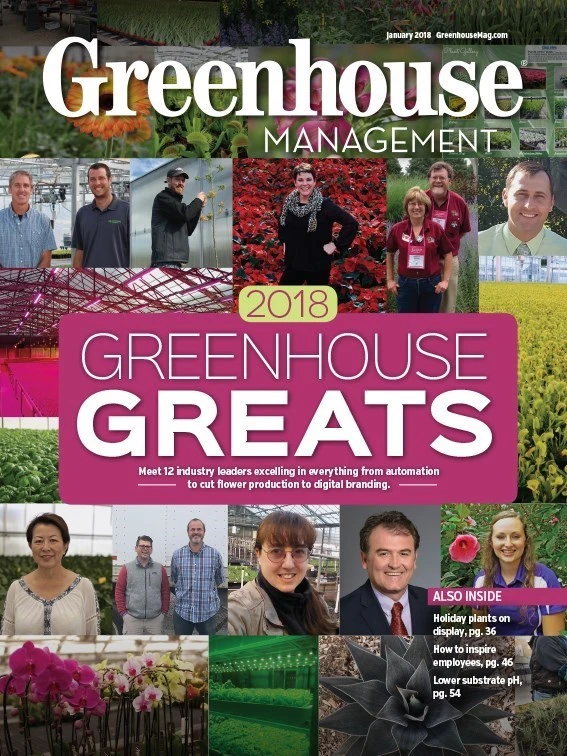
While Shenandoah Growers, the Virginia-based culinary herbs grower, does not grow cannabis, chief science officer Bob Hoffman has consulted cannabis growers, helping them troubleshoot problems and learning from them. Below, Hoffman answers questions about how growing cannabis is like growing more traditional greenhouse crops, what greenhouse professionals can learn from cannabis operations and more.
Greenhouse Management: What do you think are some of the similarities between some cannabis operations and an herb grower or a traditional ornamental greenhouse business?
Bob Hoffman: [Shenandoah Growers] is an herbs grower, which is a potted plant. And for almost 30 years before I started at Shenandoah, I was a greenhouse vegetable grower. The way that most cannabis growers in the U.S. operate is very similar to greenhouse vegetable production, especially greenhouse tomatoes where you have a vegetative stage. You’re trying to do reproductive growth through different techniques and you’re trying to balance the strength of the plant and reproductive fruit or flower growth. In those ways, it is very similar, and you can apply a lot of the same growing techniques.
GM: What are some examples of the similar techniques you see being used by cannabis growers?
BH: In greenhouse vegetable growing, you are going to go with lower [electrical conductivity] and slightly higher levels of nutrition of calcium and nitrogen at the beginning of your crop. Nutritionally, they are similar. And when [cannabis] goes into a reproductive stage, or is going into pre-flowering or flowering, you are going to lower the ratio of potassium, as well as increase your EC slightly and run your irrigations drier, or at least condense the amount of time of irrigation. You may have a longer duration of an irrigation cycle, but you’re going to start your irrigation cycles later when you go into a reproductive stage and try to build the EC and run your media a little bit drier, so that is similar as well. When you go into the full reproduction stage, whether it’s fruit or flowers, you are going with a higher EC level, a higher ratio of potassium to nitrogen, maintaining your phosphorous [levels] as well, and you’re trying to make your conditions a little harder on the plant to try and favor reproductive growth.

GM: What are innovative practices you’ve seen cannabis growers utilize, whether it’s technique or lighting or something else?
BH: [Cannabis growers’] gross income is typically higher, so they can afford to innovate when it comes to climate control, as far as lighting. They can adapt the latest techniques, spend the money and still be cost effective. Mostly HVAC installations, carbon dioxide enrichments and lighting are where cannabis [is on the cutting edge]. That, and the manipulation of the light spectrum and intensity. The other thing is that there are no real set ways of growing cannabis. Everybody is trying to grow large scale, and they are innovative in their approaches because growing practices vary heavily from grower to grower, from company to company. If you go through all of the different ways people are growing, you can find some novel ways, or new ways, or doing one technique or another that you can then adapt.
GM: What does an HVAC system offer growers, whether they are traditional greenhouse operations or a cannabis grower?
BH: No. 1, if it’s a closed system, whether it’s a greenhouse operation or a grow room, you can maintain much higher carbon dioxide levels because you are recirculating that air. You can also optimize your growing environment for dehumidifying relatively easily. In a greenhouse environment, for example, the heat is your enemy and you lose control of your environment. Light levels can be optimized for all hours of the day in a completely controlled grow room environment. You can control the hours of lighting, you can control your temperature and your temperature changes as well. In that respect, it’s fantastic for growing. We have grow rooms like this at Shenandoah Growers. It is costly initially, but it definitely has its benefits.

GM: Are there things you’re seeing cannabis growers do that you think produce or ornamental greenhouse operations should be adapting for their businesses?
BH: From that respect, it’s mostly the control of the growing environment. For the most part, cannabis is still indoor production with very extensive and sophisticated HVAC systems and lighting systems. On the flip side, cannabis growers should be taking some of the cost-saving measures and automation and labor-saving techniques of commercial vegetable growers and potted plant growers. You see more and more hybrid production for cannabis, so maybe you’ll see them growing their vegetative or their full crop in the greenhouse, depending on their environment. So, let’s say they were in higher-altitude Arizona or southern Colorado, they could have 50 to 60 percent of their energy costs offset by using natural sunlight. It seems to be coming to the middle, where more ornamental and greenhouse produce operations are controlling the environment more and more, and more cannabis growers are adapting greenhouse growing techniques.
GM: Would it be doable for a greenhouse operation to add cannabis to their production, and become a hybrid business, from a purely growing perspective? And what steps would they have to take?
BH: I think it is doable. I’m speaking personally, and not for Shenandoah Growers. If they were a greenhouse tomato grower, and they were growing on hanging gutters and already have supplemental lighting, they could add additional gutters to increase plant density and I think they’d be able to grow [cannabis] right off the bat. And I think that’s the way it’s going to go. If some bigger greenhouse vegetable players get into the cannabis market, they’ll be able to produce at a much lower cost because they are used to growing and labor saving and growing precisely at a much lower margin. I think they will be able to grow for much lower costs than some of the pure cannabis growers that haven’t grown other crops in the past.

Explore the January 2018 Issue
Check out more from this issue and find your next story to read.
Latest from Greenhouse Management
- Flexible fungicides
- Super Charged Moon Juice from Moon Valley Nurseries now available nationally
- 2025 Proven Winners Horticulture Scholarship applications now open
- How to improve inventory and shipping management in the greenhouse
- Leading Women of Horticulture: Anna Ball, Ball Hort, and Terri McEnaney, Bailey Nurseries
- GM CEA HERB Part 2: A guide to increasing the sowing density of culinary herbs
- GM CEA HERB Part 1: Best practices for producing culinary herbs in controlled environments
- USDA fires experts on invasive pests, including Asian citrus psyllid, chilli thrips






